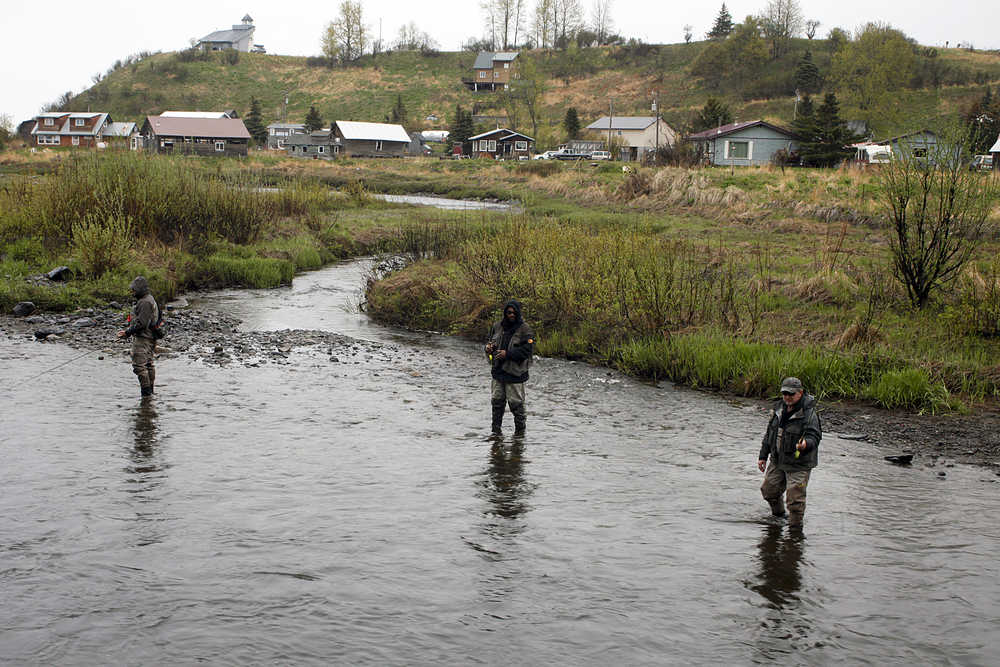Editor’s note: this story has been corrected as it contained an inaccurate geographical description for the Deshka river. It runs into the Susitna River.
A strong, early pulse of king salmon on southern and central Kenai Peninsula streams has runs off to a good start. But, managers say it is still too early to tell if the Cook Inlet’s ailing king salmon runs will rally from the last few years of poor returns.
Thirteen days after the Alaska Department of Fish and Game began counting early run king salmon on the Kenai River, there are hundreds more fish estimated to have passed the sonar by the end of May than the last two years combined. On the Anchor River, there were more kings counted in the river by May 30 than any year since 2007.
But multiple years of poor king salmon returns have led to fishing restrictions on both rivers. The Kenai River has been closed to early run king salmon fishing for the past two years, while managers closed two weekends typically open to king salmon fishing on the Anchor River and restricted the area available to fishing on the remaining opening weekends.
“So far, the king numbers are better than they have been in the past several years,” said Homer-based Fish and Game Area Management Biologist Carol Kerkvliet on the Anchor River weir and sonar data. “We are still waiting for the run to develop.”
The strong numbers could be an indication of a good-sized run or the king salmon could be hitting the rivers early, said Soldotna-based Fish and Game area management biologist Robert Begich.
Run timing can have a profound effect on how managers choose to allow fishing. In 2012, uncharacteristically low numbers of king salmon passed the sonar on the Kenai River and managers eventually closed the river entirely to king salmon fishing when they were not projecting to make their goal. It was an unprecedented move at the time and it triggered a closure in the commercial setnet fishery on the east side of Cook Inlet. The year was so bad for commercial guides, sportfishing and tourism-related businesses and commercial fishermen in the area that the U.S. Department of Commerce declared the it a fisheries disaster. Millions in disaster funding has been paid to Cook Inlet fishermen. Once the run was closed, steady numbers of fish continued to trickle into the river. After the season closed on July 31 and by the time the year ended, managers estimated that more than a quarter of the run had come in later than usual.
There are some indicators of run-timing this year, such as the catch sampling of king salmon in the popular marine recreation fishery in southern Cook Inlet. Begich said data coming from the that fishery, including the number of spawners being caught, indicates that Cook Inlet-bound fish are coming in earlier than normal.
“It’s not clear yet,” he said. “It’s too early in the season.”
While managers make projections on the size of the run, Begich said Fish and Game biologists won’t start making those projections until the first week of June.
Early on in the season, those projections have a large margin of error, but as the run progresses managers can project the run strength and estimate run timing with more confidence.
Despite the uncertainty, area managers are still hearing from anglers who see the strong, early numbers as a sign that the king salmon runs are regaining strength.
“There’s some pressure from people that just want to go out there and fish,” Begich said.
He said he’d rather see kings returning in significantly larger numbers.
“A few hundred fish a day, that’s what we want to see rather than just dozens trickling in each day,” he said. So far, the season-high day for kings on the Kenai River was May 27 when 75 fish swam past the sonar, according to Fish and Game data.
While the lower Kenai Peninsula streams have seen strong, early numbers of returning king salmon the streams conditions are different in the northern Cook Inlet streams.
On the Deshka River, a tributary of the Susitna River, managers have seen slightly fewer king salmon than they had last year.
However, Palmer-based Fish and Game Area Management Biologist Sam Ivey said anglers have reported steady king salmon catches at the mouth of the Deshka where salmon will sometimes hold when water temperatures are too high on the tributary.
“It’s early, we’re probably only one or two percent of the way into the run,” he said.
Generally, he said anglers would begin reporting strong catches near the mouth of the Deshka during the first week of June. However, hot and dry weather conditions typically cause the low-gradient Deshka to heat up quickly and king salmon will hold in the Susitna River and wait for cooler temperatures.
Ivey said he’d have a better estimation of the run timing on the Deshka by mid-June.
The low numbers haven’t stopped anglers from trying for the king salmon on the Deshka.
“Fishing success is decent for this time of year,” he said.
Reach Rashah McChesney at rashah.mcchesney@peninsulaclarion.com

